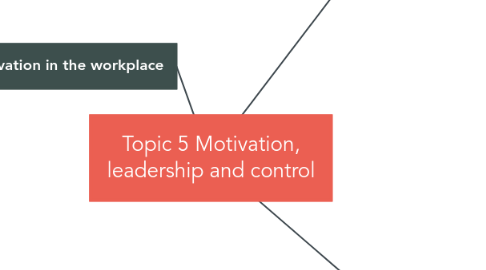
1. Motivation in the workplace
1.1. Defination- Force affecting people's behavior
1.2. The models of employee motivation theories
1.2.1. Classical Theory/ Scientific Management
1.2.2. Behavior Theory
1.2.3. Contemporary Motivatonal Theories
1.3. Theories X & Y
1.3.1. Theory X- management believes that workers need to be closely supervised and comprehensive systems of controls developed.
1.3.2. Theory Y- manager believes that, given the right conditions, most people will want to do well at work.
1.4. Two-Factor Theory (1959)
1.4.1. Motivation Factors
1.4.1.1. Achievement
1.4.1.2. Recognition
1.4.1.3. The work itself
1.4.1.4. responsibility
1.4.1.5. Advancement and growth
1.4.2. Hygiene Factors
1.4.2.1. Supervisors
1.4.2.2. Working conditions
1.4.2.3. Interpersonal relations
1.4.2.4. Pay and security
1.4.2.5. Company policies and administration
1.5. Expectancy Theory
1.5.1. Victor Vroom (1964)
1.5.2. People Work Towards Rewards
1.5.3. Behavior can be encouraged or discouraged by means of rewards or punishments.
1.6. Strategies for Enhancing Job Satisfaction and Morale
1.6.1. Reinforcement/ behavior modification
1.6.2. Management by objectives
1.6.3. Participative management and empowerment
1.6.4. Job enrichment and job redesign
1.6.5. Modified work schedules
2. Managerial styles and leadership
2.1. Defination
2.1.1. Managerial Styles- Patterns of management behavior in dealing with employees
2.1.1.1. Autocratic style
2.1.1.2. Democratic style
2.1.1.3. Free-rein style
2.1.2. Leadership- Motivating others to work
2.2. 21st Century Leadership/ Management
2.2.1. Motivation
2.2.1.1. Money no longer prime
2.2.1.2. Different desires at work
2.2.1.3. Varying lifestyles reflect varying goals of employee
2.2.2. Leadership
2.2.2.1. Flatter organizations = Less autocratic
2.2.2.2. Diversity of workplace = Diversity of leaders
2.2.2.3. Network mentality
3. Controlling
3.1. Defination
3.1.1. Controlling ensures that there is effective and efficient utilization of organizational resources so as to achieve the planned goals.
3.2. The importance of controlling
3.2.1. It facilitates co-ordination
3.2.2. It helps in planning
3.2.2.1. Controls let managers know whether their goals and plans are on target and what future actions to take.
3.2.3. Protecting the workplace
3.2.3.1. Controls enhance physical security and help minimize workplace disruptions.
3.2.3.2. Control systems provide managers with information and feedback on employee performance
3.3. Process of controlling
3.3.1. Step 1- Establish performance objective and standards
3.3.2. Step 2- Measure actual performance
3.3.3. Step 3- Compare actual performance with objectives and standards
3.3.4. Step 4- Take neccessary action

